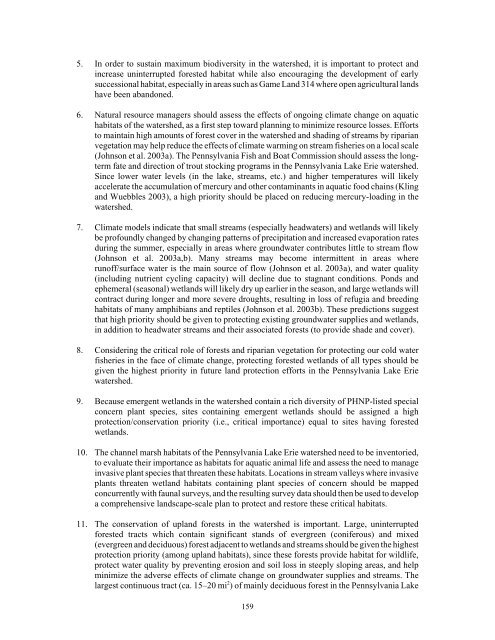Watershed Conservation Plan - Destination Erie
Watershed Conservation Plan - Destination Erie
Watershed Conservation Plan - Destination Erie
You also want an ePaper? Increase the reach of your titles
YUMPU automatically turns print PDFs into web optimized ePapers that Google loves.
5. In order to sustain maximum biodiversity in the watershed, it is important to protect and<br />
increase uninterrupted forested habitat while also encouraging the development of early<br />
successional habitat, especially in areas such as Game Land 314 where open agricultural lands<br />
have been abandoned.<br />
6. Natural resource managers should assess the effects of ongoing climate change on aquatic<br />
habitats of the watershed, as a first step toward planning to minimize resource losses. Efforts<br />
to maintain high amounts of forest cover in the watershed and shading of streams by riparian<br />
vegetation may help reduce the effects of climate warming on stream fisheries on a local scale<br />
(Johnson et al. 2003a). The Pennsylvania Fish and Boat Commission should assess the longterm<br />
fate and direction of trout stocking programs in the Pennsylvania Lake <strong>Erie</strong> watershed.<br />
Since lower water levels (in the lake, streams, etc.) and higher temperatures will likely<br />
accelerate the accumulation of mercury and other contaminants in aquatic food chains (Kling<br />
and Wuebbles 2003), a high priority should be placed on reducing mercury-loading in the<br />
watershed.<br />
7. Climate models indicate that small streams (especially headwaters) and wetlands will likely<br />
be profoundly changed by changing patterns of precipitation and increased evaporation rates<br />
during the summer, especially in areas where groundwater contributes little to stream flow<br />
(Johnson et al. 2003a,b). Many streams may become intermittent in areas where<br />
runoff/surface water is the main source of flow (Johnson et al. 2003a), and water quality<br />
(including nutrient cycling capacity) will decline due to stagnant conditions. Ponds and<br />
ephemeral (seasonal) wetlands will likely dry up earlier in the season, and large wetlands will<br />
contract during longer and more severe droughts, resulting in loss of refugia and breeding<br />
habitats of many amphibians and reptiles (Johnson et al. 2003b). These predictions suggest<br />
that high priority should be given to protecting existing groundwater supplies and wetlands,<br />
in addition to headwater streams and their associated forests (to provide shade and cover).<br />
8. Considering the critical role of forests and riparian vegetation for protecting our cold water<br />
fisheries in the face of climate change, protecting forested wetlands of all types should be<br />
given the highest priority in future land protection efforts in the Pennsylvania Lake <strong>Erie</strong><br />
watershed.<br />
9. Because emergent wetlands in the watershed contain a rich diversity of PHNP-listed special<br />
concern plant species, sites containing emergent wetlands should be assigned a high<br />
protection/conservation priority (i.e., critical importance) equal to sites having forested<br />
wetlands.<br />
10. The channel marsh habitats of the Pennsylvania Lake <strong>Erie</strong> watershed need to be inventoried,<br />
to evaluate their importance as habitats for aquatic animal life and assess the need to manage<br />
invasive plant species that threaten these habitats. Locations in stream valleys where invasive<br />
plants threaten wetland habitats containing plant species of concern should be mapped<br />
concurrently with faunal surveys, and the resulting survey data should then be used to develop<br />
a comprehensive landscape-scale plan to protect and restore these critical habitats.<br />
11. The conservation of upland forests in the watershed is important. Large, uninterrupted<br />
forested tracts which contain significant stands of evergreen (coniferous) and mixed<br />
(evergreen and deciduous) forest adjacent to wetlands and streams should be given the highest<br />
protection priority (among upland habitats), since these forests provide habitat for wildlife,<br />
protect water quality by preventing erosion and soil loss in steeply sloping areas, and help<br />
minimize the adverse effects of climate change on groundwater supplies and streams. The<br />
largest continuous tract (ca. 15–20 mi 2 ) of mainly deciduous forest in the Pennsylvania Lake<br />
159





